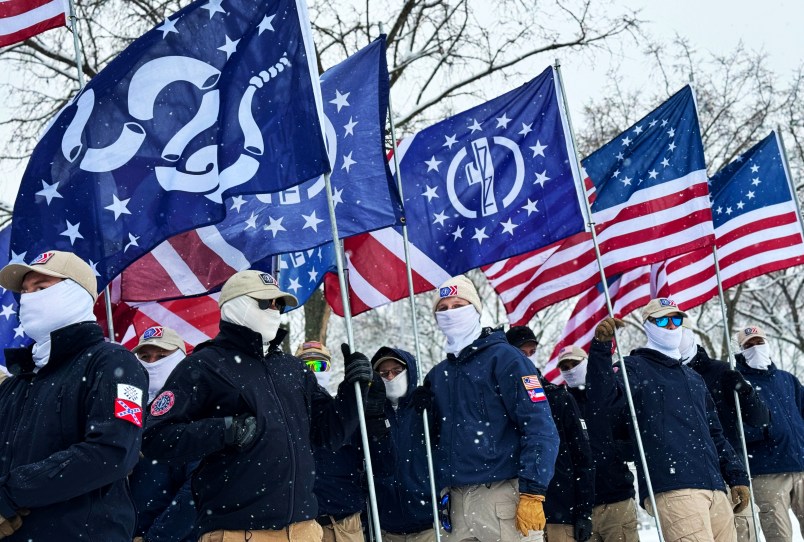This article is part of TPM Cafe, TPM’s home for opinion and news analysis. It was originally published at The Conversation.
The “great replacement theory,” whose origins date back to the late 19th century, argues that Jews and some Western elites are conspiring to replace white Americans and Europeans with people of non-European descent, particularly Asians and Africans.
The conspiracy evolved from a series of false ideas that, over time, stoked the fears of white people: In 1892, British-Australian author and politician Charles Pearson warned that white people would “wake to find ourselves elbowed and hustled, and perhaps even thrust aside by people whom we looked down.” The massive influx of immigrants into Europe at the time fostered some of these fears and resulted in “white extinction anxiety.” In the U.S., it resulted in policies targeting immigration in the late 19th and early 20th century.
In France, journalist Édouard Drumont, leader of an antisemitic movement, wrote articles in the late 19th century imagining how Jews would destroy French culture. In 1909, Filippo Tommaso Marinetti, an Italian poet and supporter of Benito Mussolini, argued that war and fascism were the only cure for the world. Fascism, then and now, worked to ensure white dominance.
This was followed by the eugenics movement, an erroneous and racist theory that supported forced sterilization of Black people, the mentally ill and other marginalized groups, who were all deemed “unfit.”
The 1978 book entitled “The Turner Diaries,” a fictional futuristic account of the overthrow of the United States government, further contributed to white nationalist ideas.
Collectively, these gave rise to a global movement that attracted a wide range of white supremacist, xenophobic and anti-immigration conspiracy theories. These theories were formally codified in the work of Frenchman Renaud Camus, first in his 2010 book “L’Abécédaire de l’in-nocence” and elaborated in his 2011 book “Le Grand Remplacement.”
Camus argued that ethnic French and white Europeans were being replaced physically, culturally and politically by nonwhite people. He believed that liberal immigration policies and the dramatic decline in white birth rates were threatening European civilization and traditions.
Why this conspiracy theory matters
These false ideas promulgated the spread of white supremacy, which has contributed to terrorist attacks, state violence and propaganda campaigns in the U.S and parts of Europe.
On Aug. 11, 2017, during a “Unite the Right” rally in Charlottesville, Virginia, white nationalists chanted “You will not replace us” and “Jews will not replace us.” In spring 2019, Belgian politician Dries Van Langenhove repeatedly posted on social media, “We are being replaced.”
In recent years, nonwhite immigrants have been the target of xenophobia. Migrants, especially from Mexico, are accused of bringing criminal activities to American cities. Immigrants have also been falsely accused of smuggling fentanyl into the U.S. The reality is that immigrants commit far fewer crimes than those born in the U.S.
Impact of the theory and spread of hate
In less than two decades, the theory has become a major idea, with as many as 60% of the French population believing some aspects of it. According to that survey, they are worried or at least concerned that they might be replaced. In the U.K. and the U.S., close to one-third of those polled believe that white people are systematically being replaced by nonwhite immigrants. Some in the U.S. fear that America might lose its culture and identity as a result.
Being aware of conspiracy theories and standing up to hatred, I argue, can help societies deal with the continuing fallout of extreme xenophobia, racist rants, the rise of white supremacy and the victimization of innocent people.
This article is republished from The Conversation under a Creative Commons license. Read the original article.







Not all Asians nor Africans nor South Americans yearn to be ignorant trailer-dwellers whose only dignity comes from imagining brown and yellow people to be somehow inferior.
Tomorrow, 3-17, is proof positive that we will never get the Irish to fully assimilate.
(Ben Franklin referred to the Irish as “swarthy”.)
I had breakfast with a 20+ year friend (he’s 73) yesterday. He was always a buttoned-up “middle-of-the road” Republican.
Not any more. Full MAGA now.
Yesterday’s topics brought up by him:
I calmly countered each statement with the facts and he wouldn’t even respond.
I won’t be calling him for a breakfast date until after the general election.
I must admit I do worry about Venezuelan immigration. Many of them, especially the men and the significant number of evangelicals among them, are likely to end up as solidly a pro-fascist voting bloc as the Cubans are.
No one wants to replace any ignorant racist who has sunk to the lowest defaults of society. They are the rubble that future civilizations will build over.